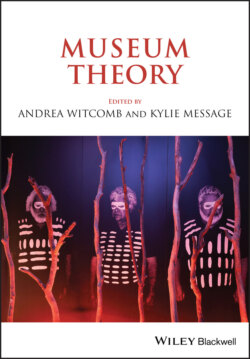Читать книгу Museum Theory - Группа авторов - Страница 52
Beyond the horizon
ОглавлениеAlterity, which we might define as “utter difference,” is that which is not programmed into humanist knowledge of the world, which, as discussed, is based on an assumption that knowledge of difference is contained in the binary opposition of us and them. Alterity is not the realm of “them,” and thus provides a site of departure from conventional binary forms of knowing. Removing the tree from our head to engage with the concept of that which we cannot know prevents the same story being told over and over. While it may seem paradoxical to claim meaning for that which is apparently without meaning, this is the tenor of what is required to think creatively outside the humanist paradigm. The commonsense opposition that is made between human and nonhuman worlds is the order of things in the humanist-oriented mind-set. In this context the term “is” reflects that something has already occurred and is being repeated. Yet this repetition has to be an illusion because, at a physical molecular level, everything is in constant flux. This state of flux, in a rational Kantian sense, gives expression to the type of engagement or “feeling” known as the sublime. It is outside the scope of this chapter to address the sublime in this context; however, suffice it to say that the tradition known as the sublime is an example of the use of reason to proscribe fixity to flux and to deem the unknowable as irrational (see Baker forthcoming).
Outside reason we venture into the fascination of abjection and monstrosity; into nonconformist spaces where it is perceived that danger lurks, spaces beyond the parameters of the “true” human or nonhuman, outside the binary humanist framing of a subject and object opposition. As soon as we venture into the murky waters of the “true,” we are faced with the problem of morality and another binary opposition between right and wrong. Yet, respect for the unknowable radical other has nothing to do with what is good or evil, although this is difficult to cogitate, given the hegemony of the humanist project. The nineteenth-century philosopher Friedrich Nietzsche observed that truth and morality are a prejudice much like astrology and alchemy. The humanist model of the museum in the academic literature is positioned to accord with the alchemy of truth rather than to venture (adventure) with alterity, and think the unknowable of difference outside reason. This is not a surprise given the sheer difficulty of thinking that which has not yet been thought. If something has not yet been thought, the concept “is” does not register; a situation which explains the Deleuzean project of always seeking to provoke new ways of thinking. This is why the style of Deleuzean writing can seem bewildering; it seeks that which is not yet. Instead of the term “is,” the conjunction “and” provides a connection between things that have neither a beginning nor an end. What this enables are thoughts outside the schemas of common sense, convention, and cliché. If we apply this conjunction of difference to a museum object such as Leonardo da Vinci’s Mona Lisa, we might share a moment with the highway blues. Or we might not. It depends on the line of thought generated by Bob Dylan’s lyric in the epigraph to this chapter, which is drawn from his song “Visions of Johanna.” For always our thoughts are multiple and lyrical; we are constantly forming experiential connections between unlike events taken from affects that may have impressed on us moments, years, or even decades before. These connections resonate beneath our cognitive radar, and yet are pivotal in our ongoing assemblage with things. In terms of meaning-making, that the Mona Lisa is a painting that transfixes some viewers tells us little. What does being transfixed by a smile actually do? That Mona “musta had the highway blues” impresses, at least for the author, with a subtle yet precise melancholy. Giving critical integrity to this type of nonlinear sensorial relation returns us to the difficulty for museums in engaging with the affective quality of cultural material outside the ideological realm.
